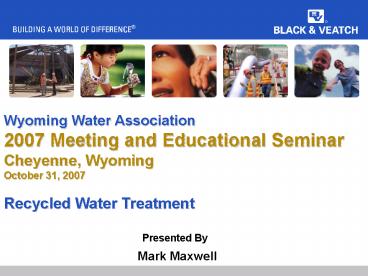Mark Maxwell - PowerPoint PPT Presentation
1 / 23
Title:
Mark Maxwell
Description:
Yield is based on the amount of non-native water imported into the Crow Creek Basin ... Tanks at Crow Creek WRF. Two Rock Media TF Tanks Were Converted to ... – PowerPoint PPT presentation
Number of Views:100
Avg rating:3.0/5.0
Title: Mark Maxwell
1
Wyoming Water Association2007 Meeting and
Educational SeminarCheyenne, WyomingOctober 31,
2007Recycled Water Treatment
Presented By
- Mark Maxwell
2
Project Must Meet Local Goals and WDEQReuse
Requirements
- Begin with the End in Mind
- Class A reuse program
- Utilize sites with high potential for public
contact - Parks, Ball Fields, Schools
- Golf Courses, Cemeteries, Streetscapes
- WDEQ Chapter 21 is principal water reuse
regulation in Wyoming
3
Water Reuse What is it?
- Yield is based on the amount of non-native water
imported into the Crow Creek Basin - This portion of the wastewater effluent can be
used for landscape irrigation and industrial
purposes - Frees up higher quality sources for potable
supply - Growing trend
- More than a dozen entities along Front Range
(including Cheyenne) - Over 1,500 cities nationwide
4
Reuse Water Availability
- Hog Park/Douglas Creek diversions provide
non-native (reusable) supply - Non-native diversions average about 3,500 AF/year
- Non-native diversions are projected to increase
- Future Casper formation wells may be designated
as non-native - Non-native supply is estimated to be about 5,000
AF/year in 2022
5
Effluent Quality Objectives for the Crow Creek
WRF
- Treatment and Discharge to Crow Creek
- 25 mg/L for CBOD
- 30 mg/L for TSS
- 3.5/8.8 mg-N/L Ammonia (Summer Average/Daily Max)
- 5.4/13.4 mg-N/L Ammonia (Winter Average/Daily
Max) - 126 E. Coli per 100 mLs
- Supplemental Disinfection for Class A Reuse
- Chemical conditioning and filtration
- Sodium Hypochlorite addition
- 2.2 fecal coliforms per 100 mLs
6
WDEQ Reuse Requirements
- Reuse Water Applier Requirements
- User Agreement with BOPU
- WDEQ Requires OM Manual
- System Description
- Access Restrictions
- Management Practices
- Monitoring/Records/Reporting
- Equipment OM Procedures
- Emergency/Spill Response
7
WDEQ Reuse Requirements
- WDEQ Management Practices
- Dont exceed irrigation ET demands
- Apply nutrients at agronomic rates
- Prevent groundwater contamination and excessive
surface runoff - No signage/fencing requirements for Class A Reuse
Water Quality
8
WDEQ Reuse Requirements
- BOPU Reporting Requirements
- Monitoring
- Fecal coliforms, Nitrate as N, Ammonia as N, and
pH - Sample at Point of Compliance once per week
- Collect information from each applier
- Location of each site
- Irrigated acreage
- Day/time of application
- Cumulative volume applied to each site
- Certification statement
9
WDEQ Reuse Requirements
- BOPU Reporting Requirements, continued
- Annual report to WDEQ
- Retain records for five years
- Water balance for State engineer
- Report wastewater volumes
- Amount available for reuse
- Amount actually reused
- Water accounting frequency
- Daily? Weekly? Monthly? Annually?
10
Treatment and Discharge Facilities at the Crow
Creek WRF
- Raw wastewater pumping
- Mechanical screening and vortex grit removal
- Primary clarification for initial BOD5 and TSS
reduction - Aerated moving bed biofilm reactors (MBBRs) for
BOD5 and ammonia removal - Secondary clarification for TSS removal
- UV disinfection using low pressure lamps in
vertical arrays with mechanical wipers - Discharge to Crow Creek
11
Reuse Treatment at Cheyenne
- Reuse water treated at the Crow Creek WRF
- UV-disinfected effluent dosed with PACI and
polymer prior to continuous backwash, deep bed,
mono-media sand filtration - Filters are rated for 4 mgd (5 mgd peak)
- Filter building expandable to 10 mgd (12.5 mgd
peak) - Filtration followed by secondary disinfection
with NaOCI to meet regulatory limit of 2.2 fecal
coliforms per 100 mLs
12
Reuse Treatment at Cheyenne
- Regulatory point of compliance is at the finished
water transfer pumps - Reuse water stored at lined pond on Prairie View
Golf Course prior to high service pumps and
distribution to reuse customers - Reuse treatment facilities completed in 2006 and
first utilized in the summer of 2007 - Demand has exceeded expectations and Cheyenne may
soon expand system
13
Schematic of the Crow Creek WRF
Oxic MBBRs
Class A Wastewater Reuse Filtration,
Disinfection, Storage Pumping Facilities
(Ammonia Removal)
To Prairie View GC and the NPWSS
Nitrate Recycle
Overflow To Dry Creek WWTP
Anoxic MBBRs
(Nitrate Removal)
Diversion Pumping Structure
Head- works
UV Disinfection
Primary Clarifiers
Secondary Clarifiers
Crow Creek
Abandon TFs Recirculation Pumping Station
Install New Sludge Collector Mechanisms
Leave Space for Supplemental Nitrate and
Phosphorous Removal Facilities
Provide Additional Standby Power for Influent
Pumping and UV Disinfection Facilities
14
Aerated MBBR Basins
Two Trains Each of 4 MBBR Basins in Series
15
Coagulant Feed Pumps
16
Dry Polymer Batching System
17
Inside the Continuous Backwash Filter Building
Air flow Indicators for Dirty Sand Air Lift Pumps
18
Cutaway View of Filer Cells
19
Dirty Sand Wash Box
20
Hypochlorite Storage Tank and Feed Pumps
21
There Are Two Reuse Storage Tanks at Crow Creek
WRF
Two Rock Media TF Tanks Were Converted to Reuse
Water Storage Basins
22
Supplemental Disinfection and Transfer Pumping
Building
23
Typical Finished Reuse Water Quality
- 2 mg/L BOD5 (99 removal)
- 2 mg/L TSS (99 removal)
- 0.6 NTU Turbidity (99 removal)
- 1 mg N/L Ammonia (95 removal)
- 2.2 FC/100 mLs (99.999 removal)































